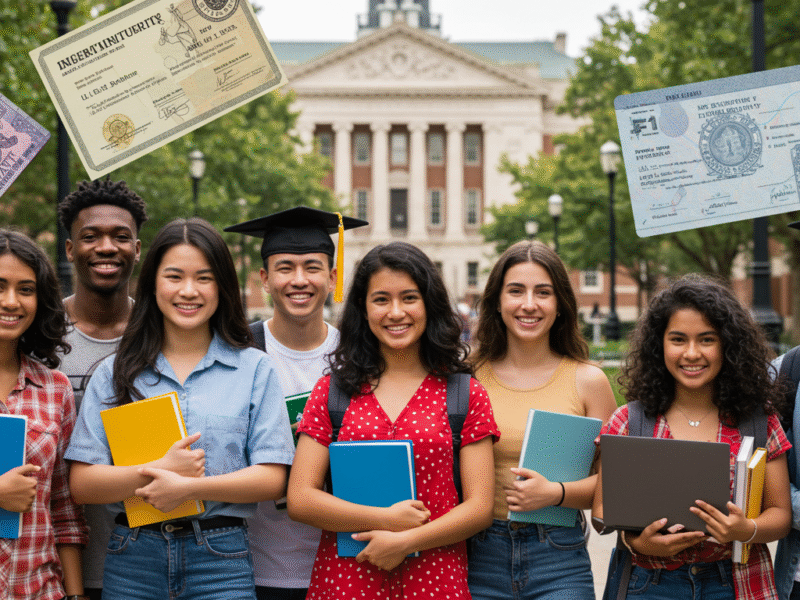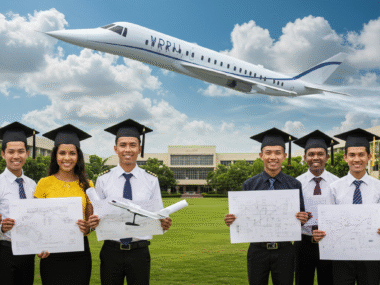Dreaming of studying in the USA but worried about the costs and visa hurdles? You’re not alone! For international students, securing undergraduate scholarships in the USA with visa sponsorship in 2025 is like finding a golden ticket to a world-class education without breaking the bank. With the right scholarship, you can cover tuition, living expenses, and even get help with visa requirements like the F-1 or J-1. This guide is packed with practical advice, key insights, and a rundown of top scholarships to help you achieve your American dream. Whether you’re from Africa, Asia, or anywhere else, let’s dive into how you can land fully funded scholarships and navigate the visa process with ease.
Studying in the USA offers access to some of the world’s best universities, cutting-edge research, and vibrant campus life. But let’s be honest—tuition fees and living costs can be daunting, especially for international students who also need visa sponsorship to study legally. The good news? Many U.S. institutions and organizations offer scholarships that not only cover expenses but also support visa applications, making your journey smoother. From prestigious programs like the Fulbright to university-specific awards, there are opportunities for talented students like you to shine.
In this article, we’ll break down everything you need to know about finding and applying for undergraduate scholarships in the USA for 2025, with a focus on those offering visa sponsorship. We’ll cover eligibility, application tips, and how to prepare for the visa process. Plus, we’ll highlight scholarships that cater to international students, including those from developing countries. Ready to take the first step toward your future? Let’s get started!
Why Study in the USA in 2025?
The USA remains a top destination for international students, and for good reason. Its universities, like Harvard, Stanford, and Yale, consistently rank among the world’s best, offering diverse programs and state-of-the-art facilities. In 2025, the U.S. is expected to host over a million international students, drawn by its academic excellence and career opportunities. But beyond academics, studying in the USA means immersing yourself in a melting pot of cultures, building global connections, and gaining skills that employers value worldwide.
For many, the biggest challenge is the cost. Tuition at top U.S. universities can range from $30,000 to $70,000 per year, and that’s before adding living expenses. Then there’s the visa process, which requires proof of financial support and acceptance into a recognized institution. Scholarships with visa sponsorship solve both problems by covering costs and ensuring you meet F-1 or J-1 visa requirements. These scholarships often include tuition, housing, and sometimes even travel allowances, making your dream of studying abroad more attainable.
Another reason to aim for 2025 is the growing focus on internationalization. U.S. universities are prioritizing diversity, offering more financial aid to students from underrepresented regions like Africa, Latin America, and Asia. Programs like the MasterCard Foundation Scholars and the AU Emerging Global Leader Scholarship are prime examples, designed to empower talented students who want to make a difference in their home countries. Let’s explore the types of scholarships available and how they can support your journey.
Types of Undergraduate Scholarships with Visa Sponsorship
When searching for scholarships, you’ll come across several types that cater to international students needing visa sponsorship. Understanding these can help you target the right opportunities. Here’s a simple breakdown of the main categories.
Fully Funded Scholarships
Fully funded scholarships are the holy grail for international students. They cover tuition, room and board, health insurance, and often include a stipend for personal expenses. Some even cover travel costs to and from the USA. These scholarships typically require a student visa (F-1 or J-1), and the sponsoring institution or organization helps ensure you meet visa requirements by providing necessary documentation.
For example, the AU Emerging Global Leader Scholarship at American University in Washington, D.C., is a fully funded award for international students. It covers all billable expenses—tuition, room, and board—for one student per year who needs an F-1 or J-1 visa. This scholarship prioritizes students with leadership potential and a commitment to improving their home communities.
Another standout is the MasterCard Foundation Scholars Program, partnered with universities like Arizona State University and Michigan State University. It supports academically talented students from Sub-Saharan Africa, covering tuition, living costs, and visa-related expenses. This program is perfect for students with a “give-back” ethos who plan to contribute to their home countries after graduation.
Merit-Based Scholarships
Merit-based scholarships reward academic excellence, leadership, or special talents like music or athletics. These are highly competitive but often include visa sponsorship as part of the award. For instance, the Clark University Global Scholars Program offers at least $10,000 per year and a guaranteed $2,500 stipend for a paid internship. It’s open to high school students who aren’t U.S. citizens or permanent residents, and Clark helps with visa documentation for accepted scholars.
The University of Arizona First-Year Global Wildcat Award is another merit-based option. It’s awarded based on your admission application, with no separate process needed. This scholarship supports international freshmen and ensures visa compliance by coordinating with the university’s international admissions office.
Need-Based Scholarships
Need-based scholarships focus on students who demonstrate financial hardship. These are ideal if you come from a low-income background but have strong academic potential. Universities like Amherst College and Cornell University offer need-based financial aid that meets 100% of demonstrated need for admitted international students. This aid often includes visa sponsorship support, ensuring you can secure an F-1 visa by proving financial backing through the scholarship.
Yale University, for example, has a need-blind admission policy for international undergraduates, meaning your financial situation doesn’t affect your admission chances. Once accepted, Yale guarantees to cover all demonstrated need, which can exceed $60,000 per year, including support for visa requirements.
Region-Specific Scholarships
Some scholarships target students from specific regions, like Africa, Asia, or Latin America, to promote diversity. The Wesleyan Freeman Asian Scholarship Program at Wesleyan University offers full funding to 11 exceptional Asian students each year. It includes visa sponsorship support, making it easier to study in Connecticut.
Similarly, the OAS Academic Scholarship Program provides up to $10,000 per year for students from OAS member states in the Americas, including the last two years of undergraduate study. This program works with partner universities to ensure visa compliance.
Each type has unique benefits, so think about your strengths—whether it’s academics, leadership, or financial need—and apply to scholarships that align with your profile. Next, let’s look at specific scholarships you can apply for in 2025.
Top Undergraduate Scholarships in the USA for 2025 with Visa Sponsorship
Here’s a detailed look at some of the best scholarships available for international students in 2025, all of which offer visa sponsorship support. These programs are designed to help you study in the USA without worrying about costs or visa complications.
1. AU Emerging Global Leader Scholarship (American University)
This prestigious scholarship is a game-changer for international students aiming to study in Washington, D.C. It covers full tuition, room, and board for one student per year who requires an F-1 or J-1 visa. To qualify, you need a minimum 3.8 GPA (out of 4.0), strong leadership skills, and a passion for community service. Preference goes to students committed to improving under-resourced communities in their home countries.
The application process involves submitting a Common Application, academic transcripts, a bank letter, and proof of English proficiency (like TOEFL or IELTS). The deadline is typically November 1, 2025, but applying by September 1 is recommended for international students. American University provides visa support by issuing the I-20 form needed for an F-1 visa.
2. MasterCard Foundation Scholars Program
Partnered with universities like Stanford, Arizona State, and Michigan State, this program targets talented students from Sub-Saharan Africa. It’s fully funded, covering tuition, housing, books, and travel. The program supports five undergraduates per year at Stanford and up to 120 at Arizona State over several years. Visa sponsorship is included, with universities providing documentation to secure an F-1 visa.
Eligibility focuses on academic excellence and a commitment to community impact. You’ll need strong grades, leadership experience, and a desire to return to Africa to contribute after graduation. Check partner university websites for specific deadlines, usually around early November.
3. Clark University Global Scholars Program
Clark University in Massachusetts offers this merit-based scholarship to international students who aren’t U.S. citizens or permanent residents. It provides $15,000 to $25,000 per year for four years, plus a $2,500 internship stipend. Clark assists with visa sponsorship by issuing the I-20 form and guiding students through the F-1 visa process.
To apply, submit your application by the early action deadline (November 15, 2025) for priority consideration. You’ll need a strong academic record, leadership potential, and English proficiency. This scholarship is renewable if you maintain good grades.
4. Berea College Scholarship
Berea College in Kentucky is unique—it offers 100% funding to all admitted international students for their first year. This includes tuition, room, board, and fees. After the first year, students contribute through work-study programs, but additional aid is available if needed. Berea supports visa sponsorship by providing financial documentation for the F-1 visa.
Applicants need strong academics and demonstrated financial need. The application deadline is typically January 15, 2025. Berea’s commitment to affordability makes it a top choice for students from developing countries.
5. Illinois Wesleyan University Scholarship
This fully funded scholarship covers full tuition, ranging from $16,000 to $30,000 per year, for international undergraduates. Illinois Wesleyan helps with visa sponsorship by providing the I-20 form and financial certification required for an F-1 visa. To qualify, you need excellent grades and a completed application by February 15, 2025.
The scholarship is merit-based, so highlight your academic achievements, extracurriculars, and leadership in your application. English proficiency tests like TOEFL or IELTS are required.
6. #YouAreWelcomeHere Scholarship
Offered by 57 participating U.S. colleges, this scholarship provides at least 50% tuition coverage for two international undergraduates per institution. It’s aimed at students passionate about intercultural learning. You’ll need to submit an essay or multimedia project showcasing your leadership skills. Participating schools, like Temple University, assist with visa sponsorship by providing I-20 forms.
Deadlines vary by institution, so check each college’s website. Applications typically open in May 2025 for the 2026 academic year.
These scholarships are just the start. Others, like the Yale University Scholarship (need-based, up to $70,000/year) and the Boston University Presidential Scholarship ($25,000/year), also offer visa support for international students. Always check university websites for the latest deadlines and requirements.
How Visa Sponsorship Works for International Students
Securing a student visa is a critical step for studying in the USA. Most international students need an F-1 visa (for academic programs) or a J-1 visa (for exchange programs). Scholarships with visa sponsorship make this process easier by providing financial documentation and institutional support. Here’s how it works in simple terms.
Step 1: Get Accepted and Receive a Scholarship
First, you need to be accepted into a U.S. college or university and awarded a scholarship. The institution will issue a Form I-20 (for F-1 visas) or DS-2019 (for J-1 visas), which certifies your enrollment and financial support. Fully funded scholarships, like the AU Emerging Global Leader, ensure you meet the financial requirements for a visa by covering tuition and living costs.
Step 2: Pay the SEVIS Fee
Before your visa interview, you’ll pay the SEVIS (Student and Exchange Visitor Information System) fee, currently around $350. This registers you in the U.S. government’s database for international students. Your scholarship provider or university often guides you through this step.
Step 3: Schedule a Visa Interview
Book an appointment at the U.S. Embassy or Consulate in your home country. Bring your I-20 or DS-2019, SEVIS fee receipt, passport, and proof of ties to your home country (to show you’ll return after your studies). Scholarships that cover full expenses make it easier to prove financial stability, a key visa requirement.
Step 4: Attend the Interview and Get Your Visa
During the interview, explain your study plans and how the scholarship supports you. Be honest and confident. If approved, you’ll receive your visa, allowing you to enter the USA as a student. Universities like American and Clark provide advising to help you prepare for this process.
Keep in mind that visa rules can change. In 2025, there’s talk of stricter policies, so apply early and stay updated via the U.S. Embassy website.
Eligibility Criteria for Scholarships with Visa Sponsorship
Eligibility varies by scholarship, but most share common requirements. Here’s what you’ll typically need:
- Academic Excellence: A strong GPA (3.5–4.0 out of 4.0) and competitive test scores (SAT, ACT, or equivalent). Some scholarships, like Yale’s, are need-blind, so grades matter more than finances.
- English Proficiency: TOEFL, IELTS, or Duolingo scores are often required. For example, the AU Emerging Global Leader Scholarship asks for a TOEFL score of 95+ or IELTS 7.0+.
- Leadership and Community Service: Many scholarships, like the MasterCard Foundation, prioritize students with a track record of volunteering or leadership.
- Financial Need: Need-based scholarships require proof of limited financial resources, like family income statements or bank letters.
- Non-U.S. Citizenship: Most scholarships are for international students who aren’t U.S. citizens or permanent residents. You’ll need to qualify for an F-1 or J-1 visa.
- Specific Regional or Program Criteria: Some scholarships target certain regions (e.g., Africa for MasterCard) or fields like STEM or humanities.
Always check the scholarship’s website for exact requirements. Missing one document can derail your application, so be thorough.
How to Apply for Undergraduate Scholarships in 2025
Applying for scholarships can feel like a marathon, but with a clear plan, you’ll cross the finish line. Here’s a step-by-step guide to boost your chances.
Step 1: Research Early
Start your search at least 12–18 months before the academic year begins (fall 2025). Use resources like:
- Scholars4Dev: Lists scholarships for international students from developing countries.
- InternationalStudent.com: Offers a free scholarship search database.
- University Websites: Check financial aid pages for schools like Amherst, Clark, or Yale.
Focus on scholarships offering visa sponsorship, as they’ll provide the I-20 or DS-2019 forms needed for your visa.
Step 2: Prepare Your Documents
Gather these essentials:
- Academic Transcripts: Translated into English if needed.
- Standardized Test Scores: SAT, ACT, TOEFL, or IELTS.
- Recommendation Letters: Get 2–3 from teachers or community leaders who know you well.
- Personal Statement or Essay: Highlight your goals, leadership, and why you want to study in the USA. Tailor it to each scholarship.
- Proof of Financial Need: For need-based awards, include bank statements or income documents.
- Passport: Ensure it’s valid for at least six months beyond your intended stay.
Step 3: Apply to Universities and Scholarships
Most scholarships require you to apply to the university first. Use the Common Application or Coalition Application for many U.S. schools. Submit scholarship applications through the university’s portal or directly to the scholarship provider. For example, the AU Emerging Global Leader Scholarship requires a bank letter and AU Declaration of Finances Form.
Step 4: Follow Up and Meet Deadlines
Deadlines for 2025 scholarships typically fall between November 2024 and March 2025. Early action deadlines (e.g., November 1 for Arizona) give you priority. Track your applications and follow up with admissions offices if needed.
Step 5: Prepare for Interviews
Some scholarships, like the #YouAreWelcomeHere, may require interviews or multimedia submissions. Practice answering questions about your goals, leadership, and why you chose the USA. Be authentic—scholarship committees value genuine passion.
Step 6: Secure Your Visa
Once awarded a scholarship, work with your university’s international student office to get your I-20 or DS-2019. Schedule your visa interview early, as wait times can be long, especially in 2025 with potential policy changes.
Tips to Boost Your Scholarship Application
Want to stand out? Here are practical tips to make your application shine:
- Highlight Leadership: Share stories of how you led a school project, volunteered, or solved a community problem. For example, the MasterCard Foundation loves students with a “give-back” mindset.
- Write a Compelling Essay: Be personal. Explain how studying in the USA will help you achieve your dreams and impact your home country. Avoid generic answers.
- Get Strong Recommendations: Choose referees who can speak to your academic and personal strengths. Give them plenty of time to write detailed letters.
- Apply to Multiple Scholarships: Don’t put all your eggs in one basket. Apply to several, like Berea, Clark, and #YouAreWelcomeHere, to increase your chances.
- Meet English Requirements: A high TOEFL or IELTS score (e.g., 95+ or 7.0+) can set you apart. Practice early if English isn’t your first language.
- Show Financial Need Clearly: For need-based scholarships, be transparent about your financial situation with proper documentation.
Challenges and How to Overcome Them
Applying for scholarships and visas isn’t always smooth sailing. Here are common hurdles and how to tackle them:
- High Competition: Scholarships like the AU Emerging Global Leader are highly competitive, with thousands applying for one spot. Solution: Apply to less competitive programs like the OAS Scholarship or regional awards.
- Visa Denials: Some students face visa rejections due to incomplete documents or weak ties to their home country. Solution: Provide strong proof of your intent to return home, like family ties or a job plan, and double-check all paperwork.
- Cost of Applications: Application fees and test costs can add up. Solution: Request fee waivers from universities (many offer them for international students) and look for free scholarship databases like InternationalStudent.com.
- Deadlines: Missing a deadline can ruin your chances. Solution: Create a calendar with all deadlines and start preparing 12–18 months in advance.
Other Ways to Fund Your U.S. Education
If scholarships don’t cover everything, consider these options:
- Part-Time Work: F-1 visa holders can work up to 20 hours per week on campus. This can help with personal expenses, though it’s limited.
- Crowdfunding: Platforms like GoFundMe allow you to raise funds from friends, family, or supporters for education costs.
- Work-Study Programs: Schools like Berea require students to work on campus in exchange for aid, which can offset costs.
- Private Loans: Some lenders, like MPOWER Financing, offer loans for international students without a U.S. cosigner. These can complement scholarships but require repayment.
Always check with your university’s international student office for additional funding options or visa-compliant work opportunities.
Why 2025 Is the Perfect Year to Apply
The landscape for international students in 2025 is promising but comes with caveats. Universities are expanding scholarship programs to attract diverse talent, and many are streamlining visa support to counter potential policy tightening. Programs like the MasterCard Foundation and #YouAreWelcomeHere are increasing their reach, offering more spots for students from developing countries.
However, posts on X suggest concerns about visa policy changes, which could make early applications critical. Starting your search now ensures you’re ahead of the curve, with time to gather documents, prepare for tests, and perfect your applications.
Final Thoughts: Your Journey Starts Here
Landing an undergraduate scholarship in the USA with visa sponsorship in 2025 is challenging but absolutely achievable. With fully funded options like the AU Emerging Global Leader, MasterCard Foundation, and Berea College scholarships, you can study at top universities without financial stress. The key is to start early, tailor your applications, and show your unique strengths—whether it’s academic brilliance, leadership, or a commitment to change.
Take a deep breath, make a plan, and dive into the process with confidence. Your dream of studying in the USA is closer than you think. Check out the resources below to begin your scholarship search, and don’t hesitate to reach out to university admissions offices for guidance. You’ve got this!
Resources for Further Reading:











